Red Leaf Lettuce: Unlock Fresh & Nutritious Garden Growth
Red leaf lettuce isn’t just a pretty face in the garden; it’s a powerhouse of nutrition and a versatile addition to your meals. Whether you’re a seasoned gardener or just starting out, this leafy green offers a range of benefits that make it worth growing. From its vibrant color to its crisp texture, red leaf lettuce is a favorite in salads and wraps. But there’s more to it than just taste. Growing your own can save you money and offer a fresh, pesticide-free option for your table. Let’s dive into what makes red leaf lettuce a standout choice for your garden and kitchen.
Table of Contents
Understanding the Benefits of Red Leaf Lettuce
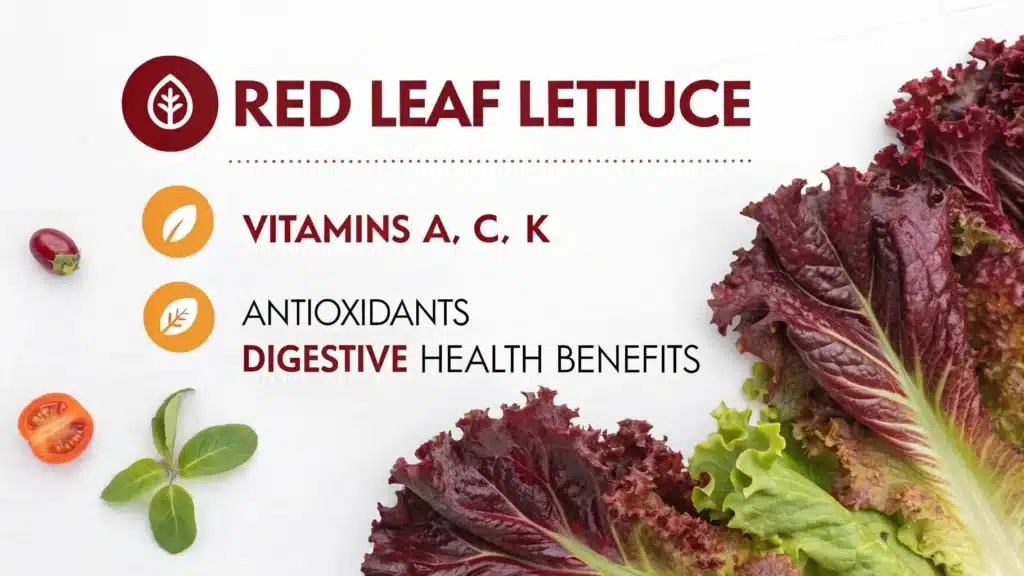
Nutritional Advantages
Red leaf lettuce is an excellent source of essential nutrients that contribute to a balanced diet. Packed with vitamins A and K, it supports eye health and bone strength. Its antioxidants, like beta-carotene, help fend off oxidative stress, keeping your cells healthy. Moreover, this leafy green is low in calories, making it a smart choice for those mindful of their “leaf lettuce fat” intake.
Culinary Uses
In the kitchen, red leaf lettuce is a versatile player. It adds a pop of color and a unique flavor to salads, sandwiches, and wraps. Its slightly sweet and nutty taste enhances dishes, while its vibrant color makes meals visually appealing. Whether you’re tossing it with fruits and nuts or layering it in a sandwich, red leaf lettuce elevates the culinary experience.
Cultural Significance
Beyond its nutritional and culinary benefits, red leaf lettuce holds cultural value. Historically, it has been used not just as food but for its medicinal properties, symbolizing health and vitality across various cultures. Its presence in traditional dishes highlights its role in promoting wellness and enriching culinary traditions.
Incorporating red leaf lettuce into your diet not only boosts your nutrition benefit but also adds a delightful twist to your meals. Embrace this leafy green for its health benefits and cultural richness, making it a staple in your kitchen.
How to Grow Red Leaf Lettuce Successfully
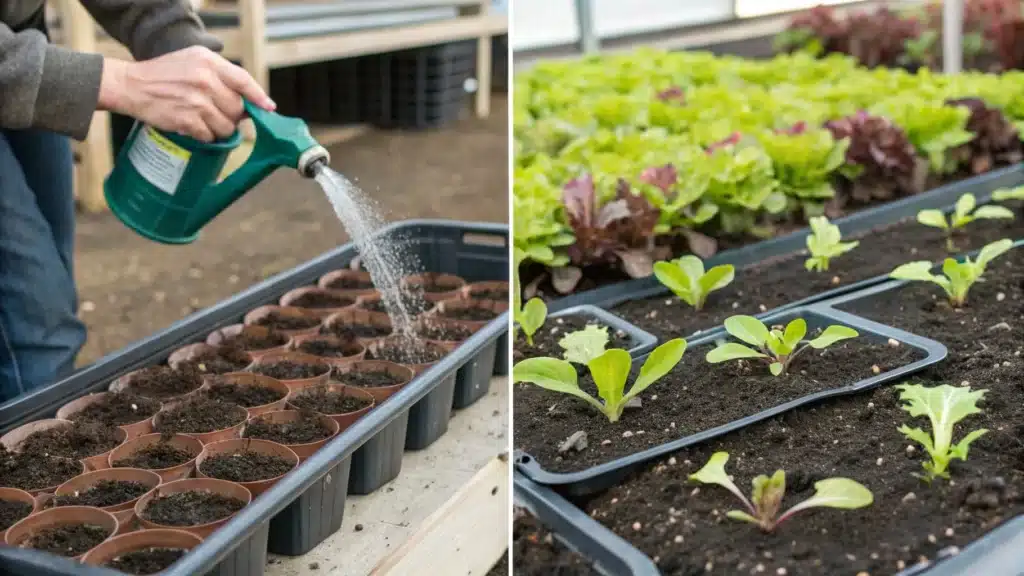
Choosing the Right Soil and Location
Growing red leaf lettuce starts with selecting the ideal soil and spot in your garden. This lettuce plant thrives in well-draining, fertile soil. The soil should be rich in organic matter, which can be achieved by mixing in compost before planting. Aim for a pH level between 6.0 and 7.0 for optimal growth. Position your plants where they can receive full sun to partial shade, as too much direct sunlight can cause the leaves to wilt.
- Prepare the soil by removing debris and rocks.
- Test soil pH and amend if necessary.
- Ensure the site gets at least 6 hours of sunlight per day.
Timing Your Plantings for Optimal Growth
Timing is everything when it comes to planting red leaf lettuce. For a continuous supply of fresh, homegrown lettuce, sow seeds as soon as the soil can be worked in the spring. This variety prefers cooler temperatures, so early planting helps avoid the heat of summer which can lead to bolting.
- Start seeds indoors 4-6 weeks before the last frost date.
- Transplant seedlings outdoors after hardening them off for 2-3 days.
- Stagger plantings every two weeks for a steady harvest.
Planting in the fall can also be successful, as cooler autumn temperatures enhance the flavor and texture of the lettuce.
Harvesting Techniques for Maximum Yield
Harvesting red leaf lettuce correctly ensures you get the most from your plants. For a “cut and come again” approach, pick outer leaves first, allowing the inner leaves to continue growing. This method not only prolongs the harvest period but also maintains plant health.
- Use clean scissors or a knife to avoid damaging the plant.
- Harvest in the morning when leaves are crisp and hydrated.
- Regularly pick leaves to encourage new growth.
Exploring Different Varieties of Red Leaf Lettuce
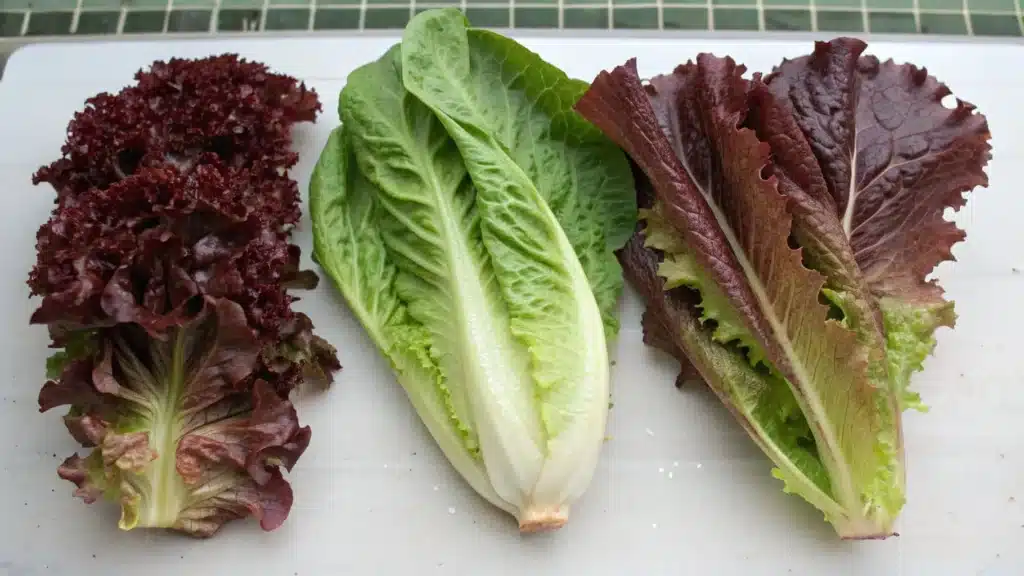
Characteristics of Red Romaine
Red Romaine lettuce, a standout among lettuce variety, is known for its striking burgundy-red leaves that form a compact, upright head. Its robust leaves have a sweet yet slightly bitter taste, making it a perfect addition to salads or wraps. This variety thrives in diverse climates and can be grown in gardens or indoor containers, making it a versatile choice for both novice and experienced gardeners. Its vibrant color not only adds aesthetic value to dishes but also signifies its rich nutrient content.
For more information on the longevity of romaine lettuce, click here.
Comparing Loose-Leaf and Crisphead Types
When considering the types of lettuce to grow, it’s important to understand the differences between loose-leaf and crisphead varieties. Loose-leaf lettuces, like the Red Oak Leaf, offer a softer texture and can be harvested leaf-by-leaf, providing a continuous supply. On the other hand, crisphead varieties, such as iceberg lettuce, form tight, crunchy heads and are harvested all at once. Each type has its own unique benefits, with loose-leaf being more adaptable to varying climates and crisphead offering a satisfying crunch.
Selecting Seeds for Climate Resilience
Choosing the right seeds is crucial for successful cultivation, especially when aiming for climate resilience. Red leaf lettuces, such as Lollo Rossa, are particularly heat-tolerant due to their anthocyanin-rich leaves, which provide some UV protection. For cooler climates, consider varieties that are known for their cold-hardiness, like Winter Density. By selecting seeds that match your local climate, you can enjoy green tender lettuce throughout the growing season.
Growing a diverse range of heirloom lettuce varieties not only enriches your garden but also your palate. Each variety brings something unique to the table, from taste to texture, ensuring a delightful and nutritious harvest.
Maximizing Your Garden Space with Red Leaf Lettuce
Space-Efficient Planting Techniques
To make the most of your garden, start by planting red leaf lettuce just an inch deep. This shallow planting technique not only saves space but also encourages quicker germination. Consider using raised beds or vertical gardens to optimize your area further. By utilizing every inch wisely, you can increase your yield without needing more land.
Companion Planting Strategies
Red leaf lettuce pairs well with a variety of other plants, enhancing growth and flavor. Plant it alongside carrots, radishes, or onions to create a symbiotic environment. These companions can help deter pests naturally, reducing the need for chemical interventions. A simple list of good companions includes:
- Carrots
- Radishes
- Onions
- Chocolate Mint Plant
- fresh oregano
- Armenian Cucumber
Urban Gardening Solutions
Even if you’re working with a small urban space, red leaf lettuce can thrive. Use containers or window boxes to grow your lettuce on balconies or patios. These methods are perfect for urban dwellers who wish to enjoy fresh produce without a traditional garden.
Growing red leaf lettuce in confined spaces is not just about saving room; it’s about creating a sustainable urban oasis. With the right techniques, even the smallest balcony can become a lush, productive garden.
Health Benefits of Incorporating Red Leaf Lettuce in Your Diet
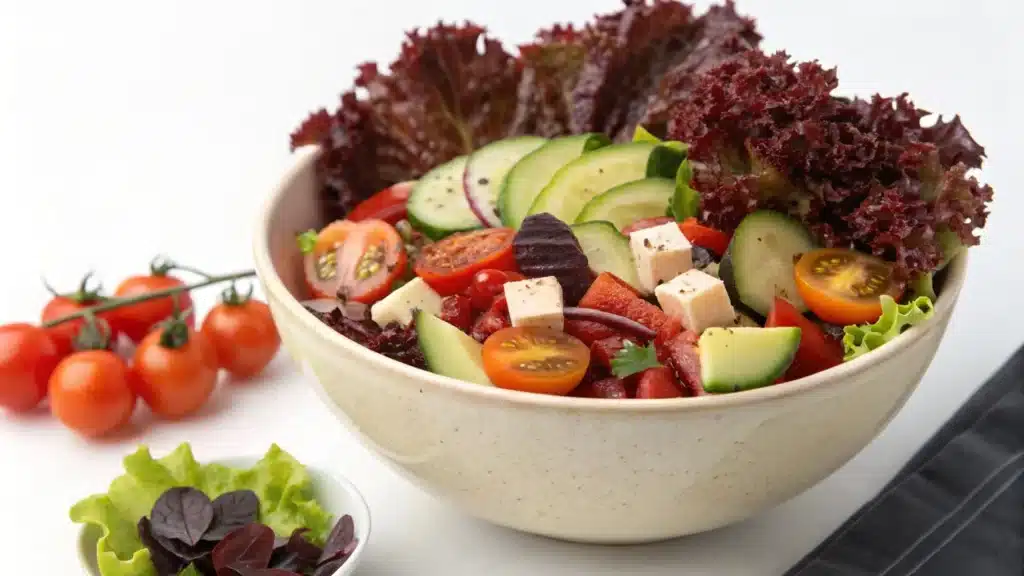
Aiding Digestion and Gut Health
Red leaf lettuce is a fantastic choice for those looking to improve their digestive health. Packed with dietary fiber, it supports regular bowel movements and contributes to a healthy gut. Including red leaf lettuce in your meals can make a noticeable difference in how you feel. It’s like giving your digestive system a gentle nudge in the right direction.
Promoting Heart Health
Adding red leaf lettuce to your diet can be a step towards better heart health. This leafy green is rich in antioxidants and anti-inflammatory properties, which are known to support cardiovascular wellness. When you make red leaf lettuce a regular part of your meals, you’re not just adding flavor—you’re also taking a proactive approach to maintaining a healthy heart.
Boosting Immune Function
Red leaf lettuce offers more than just crunch and color to your plate. It’s a powerhouse of vitamins, particularly A and C, which are essential for a robust immune system. By incorporating this nutrient-rich food into your diet, you are helping your body fend off illnesses and infections more effectively.
Red leaf lettuce is more than just a salad ingredient; it embodies the essence of fresh, healthy eating. Its vibrant color and crisp texture are often associated with wellness and vitality, making it a staple in health-conscious diets.
Economic and Environmental Impact of Growing Red Leaf Lettuce
Cost-Effectiveness of Home-Grown Lettuce
Growing your own red leaf lettuce can be a real money-saver. Imagine cutting down on your grocery bills by harvesting fresh lettuce from your garden instead of buying it from the store. Seeds are inexpensive, and a single packet can yield a surprising amount of produce. Plus, you can avoid the premium prices often charged for organic lettuce at the supermarket.
Here’s a simple breakdown of potential savings:
| Item | Store-Bought Cost | Home-Grown Cost |
|---|---|---|
| Organic Red Leaf Lettuce | $3 per head | $0.50 per head |
| Annual Consumption (20 heads) | $60 | $10 |
Reducing Food Waste
Home gardening allows you to pick only what you need, reducing the amount of lettuce that goes to waste. In contrast, store-bought lettuce often spoils before it can be used, leading to unnecessary waste. By growing your own, you ensure that every leaf is used to its fullest potential.
- Harvest as needed
- Use fresh, crisp leaves
- Compost any unusable parts
Sustainable Gardening Practices
Cultivating red leaf lettuce in your garden promotes sustainable practices. By growing your own, you reduce the carbon footprint associated with transporting produce from farms to stores. Additionally, you can use natural fertilizers and pest control methods, which are kinder to the environment.
Embracing home gardening not only benefits your wallet but also supports a healthier planet. Every small step towards sustainability counts, and growing your own lettuce is a simple yet effective way to contribute.
Troubleshooting Common Issues in Red Leaf Lettuce Cultivation
Identifying Pests and Diseases
Red leaf lettuce can fall victim to pests and diseases that can ruin your crop. Aphids, slugs, and caterpillars are notorious for munching away at the leaves. Keep an eye out for any unusual spots or discolorations, which might indicate a fungal infection or pest problem. Regular inspection is key to catching these issues early. Consider using organic pest control methods to keep your lettuce safe without harsh chemicals.
Preventing Bolting and Flowering
Bolting happens when lettuce shifts its energy from leaf production to flowering, often due to stress from high temperatures or too much sunlight. This not only affects the taste but also the texture of the leaves. To prevent bolting, ensure your lettuce gets enough shade during hot days and maintain consistent watering. The “inch of soil feel” method is handy—water when the top inch of soil feels dry to the touch.
Ensuring Proper Watering and Sunlight
Proper watering and sunlight are crucial for healthy red leaf lettuce. Overwatering can lead to root rot, while underwatering can cause wilting. Aim for even moisture by watering when the top inch of soil feels dry. As for sunlight, lettuce prefers cooler temperatures, so providing some afternoon shade can help prevent bolting. Remember, balance is essential to avoid stress on the plants.
Inconsistent watering or exposure to high heat can cause brown spots on your lettuce leaves. Make sure to water evenly and shield your plants from excessive sun to keep them thriving.
Conclusion
Growing this leafy green in your garden is a win-win. Not only do you get to enjoy fresh, tasty greens right from your backyard, but you also save some cash and avoid the chemicals found in store-bought options. Plus, there’s something really satisfying about eating what you’ve grown yourself. Whether you’re a seasoned gardener or just starting out, it’s a great choice. It’s easy to grow, quick to harvest, and fits perfectly in small spaces. So why not give it a try and add a splash of color and health to your meals?
Frequently Asked Questions
What is red leaf lettuce and why is it popular?
Red leaf lettuce is a type of leafy green vegetable known for its vibrant red-tinted leaves and crisp texture. It’s popular because it’s not only tasty but also packed with nutrients, making it a favorite in salads and healthy meals.
How do I grow red leaf lettuce in my garden?
Choose a sunny spot with well-draining soil. Plant seeds in early spring or fall when temperatures are cool. Keep the soil moist and harvest the outer leaves as they mature for a continuous supply.
What are the health benefits of eating red leaf lettuce?
Red leaf lettuce is rich in vitamins A and K, which are good for your eyes and bones. It’s also high in fiber, helping with digestion, and contains antioxidants that support heart health.
Can red leaf lettuce be grown indoors?
Yes, red leaf lettuce can be grown indoors. Use pots with drainage holes, place them near a sunny window or under grow lights, and water regularly to keep the soil moist but not soggy.
How do I prevent pests from attacking my red leaf lettuce?
To keep pests away, check your plants regularly and remove any insects by hand. You can also use natural remedies like neem oil or plant companion plants that repel pests, such as marigolds.
What should I do if my red leaf lettuce starts to bolt?
If your lettuce starts to bolt, it means it’s going to seed, usually due to warm temperatures. Try to harvest the leaves before this happens, and consider planting earlier in the season or providing shade during hot weather.

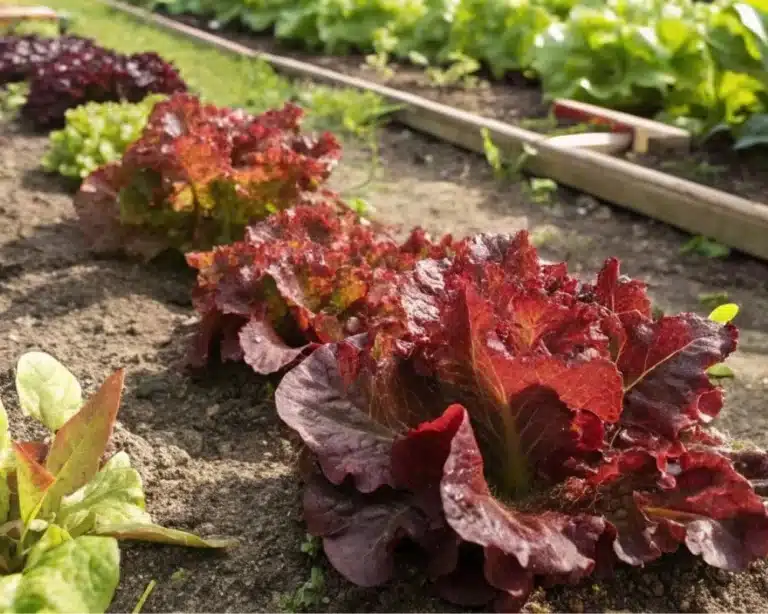
1 thought on “Red Leaf Lettuce: Unlock Fresh & Nutritious Garden Growth”